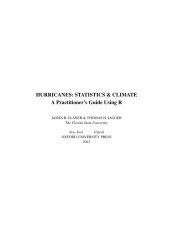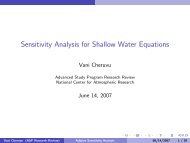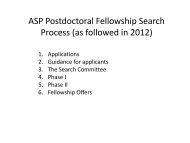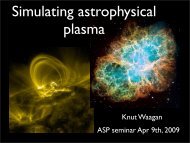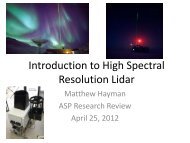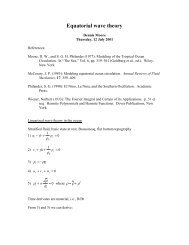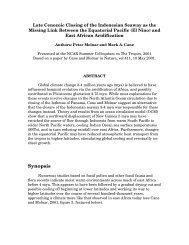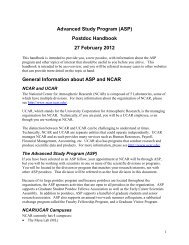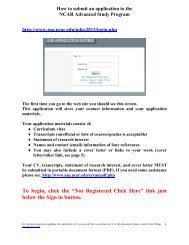Building Holodec 2
Building Holodec 2
Building Holodec 2
Create successful ePaper yourself
Turn your PDF publications into a flip-book with our unique Google optimized e-Paper software.
<strong>Building</strong><br />
HOLODEC 2<br />
ASP Research Review
Outline<br />
• Project Summary<br />
• Optical Design<br />
• Mechanical Design<br />
• Hologram Processing Code Design
HOLODEC 2<br />
Project Summary<br />
Description<br />
Science Goals<br />
Timeline
HIAPER Gulfstream GV<br />
C-130 Hercules Q<br />
HOLODEC 2 (Holographic Detector for Clouds 2)<br />
is an airborne instrument that measures the size,<br />
shape, and relative 3D position of cloud particles in a<br />
local sample volume using digital in-line holography.
HOLODEC 1
HOLODEC 2<br />
Principal Science Goals
x 10<br />
Relative Lengths<br />
The HOLODEC 2 has a<br />
sample volume of 15.6 cm 3 or:<br />
14.6 x 9.74 x 110 mm<br />
The FSSP sample volume size<br />
to obtain a 15.6 cm 3 is<br />
Relative Crosssections<br />
approximately:<br />
2.5 x 0.1 x 62300 mm
HOLODEC 2<br />
Principal Science Goals<br />
• Determine the variability of local size<br />
distributions of cloud particles of ~5 μm<br />
extent and larger.<br />
• Measure how strongly cloud particles<br />
cluster on sub-cm scales due to<br />
turbulence, mixing and entrainment of<br />
clouds.
HOLODEC 2<br />
Principal Science Goals<br />
• Examine the spatial distribution and<br />
partitioning of cloud ice and liquid water<br />
particles in mixed-phase regions of cloud<br />
on sub-cm scales.<br />
• Measure the size distribution of small-ice<br />
particles after rejecting shards of<br />
shattered ice crystals that tend to cluster<br />
in particular regions of the threedimensional<br />
sample volume.
HOLODEC 2<br />
Timeline so far<br />
• March 2008: Project proposed to MAC.<br />
• April 2008: EOL funds project.<br />
• May 2008: Optical system design begins.<br />
• June 2008: Camera and laser arrive.<br />
• October 2008: Custom lenses arrive<br />
• November 2008: Mechanical design of<br />
project begins.<br />
• January 2009: ASP and EOL fund rest of<br />
project.
HOLODEC 2<br />
Timeline to come<br />
• Feb 2009: Complete optical system test.<br />
Complete mechanical design and begin<br />
fabrication of instrument body. Model flow<br />
around proposed instrument head design.<br />
• April to May 2009: Finish instrument<br />
fabrication, test whole system, certify for<br />
flight on HIAPER.<br />
• July 1-15, 2009: Test flights during HEFT-09.<br />
• Fall 2009: Process test flight holograms and<br />
analyze results.
Optical Design
Optical Design<br />
• Design allows for temperature range of -60 to +35<br />
C.<br />
• Alignment requirements are typically less than<br />
~50 to 200 μm decenter and ~0.1 to 0.2 degree tilt.<br />
• Tube must be pressurized to ~1 atm dry nitrogen.
Mechanical Design
Mechanical Design<br />
Constraints For Probe<br />
• Aircraft Certification Requirements<br />
• Weighs less than 25 pounds (not counting can).<br />
• Less than 50 square inches frontal cross section.<br />
• No permanent deformation from 100 pounds force<br />
in any direction on probe arms and tips.<br />
• Symmetric such that aerodynamic drag does not<br />
induce a significant torque.<br />
• Center of gravity well inside PMS can.
Mechanical Design<br />
Constraints on Probe<br />
• Science Constraints<br />
• Desire 14 cm or ~5.5 in between windows.<br />
• Need optics and windows clean and dry even in<br />
freezing cloud conditions.<br />
• Need passage for Gigabit ethernet connection.<br />
• Desire aerodynamic shape such that natural<br />
condition of cloud particles is minimally<br />
changed at the sample volume by the probe and<br />
aircraft speeding by at 225 m s -1 .
Mechanical Design<br />
Electronics<br />
Laser<br />
Box<br />
Camera<br />
Turning<br />
Mirror<br />
Camera Side<br />
Lens System
Mechanical Design<br />
Fiberglass<br />
Shroud
Hologram Processing<br />
Code Design
Hologram Processing<br />
Code Design<br />
• GPU hologram reconstruction has<br />
proven to be order 25 times faster than<br />
reconstruction on a comparable CPU,<br />
but a CPU still necessary for postreconstruction<br />
processing.<br />
• Reconstruction to be run on NCSA<br />
Lincoln Supercomputer through the<br />
TeraGrid project.
<strong>Building</strong><br />
HOLODEC 2<br />
Thank you and Any Questions<br />
Onward Ever Onward



